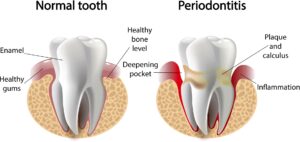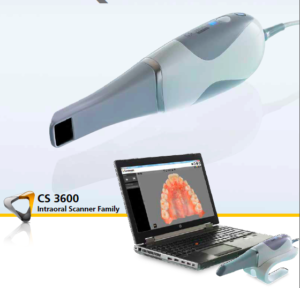Header logo
header top contact widget
Learn More Blog
Nothing To Fear To Accomplish Healthy Smile Here
Posted on Apr 16, 2023 by William J. Claiborne, DDS MS
As a dental specialist, I find that many people are unfamiliar with exactly what a periodontist does. Yet, when they are recommended to see me (typically by their general dentist), it is because they need specialized care that falls under our unique set of skills.
A periodontist has advanced skills to help patients with a variety of needs that involve the gum tissues. These include:
– Treatment of all stages of gum disease (gingivitis, pregnancy gingivitis, periodontal disease, periodontitis)
– Reshaping gum tissues for esthetic enhancement (crown lengthening, gingivectomy for ‘gummy smiles’, repairing areas of gum recession)
– Diagnosis and placement of dental implants
– Treatment of lesions or cysts in oral tissues
Let’s begin with gum disease.
Because the majority of care I provide has to do with the treatment of all stages of periodontal disease, it may be helpful to understand how this develops. Although many people delay or avoid regular dental care (mistakenly thinking “if nothing hurts, then nothing must be wrong”), I have a close-up view of its destructive nature. Its formation creates cavities, periodontal (gum) disease, and leads to eventual tooth loss.
Even people who are committed to a regimen of thorough at-home oral hygiene (twice-daily brushing, daily flossing), can be doing an insufficient job of removing the daily buildup of plaque. Plaque is a sticky film of bacteria that accumulates in the mouth. When not thoroughly removed, it can harden into a mass that attaches to the base of, or in-between, teeth.
In the form of tartar, this cement-hard mass of bacteria cannot be brushed or flossed away. Once tartar forms, it can only be removed by a dentist or hygienist using special tools. Without removal, it will continue to amass and attack gum tissues, working its way beneath the gum line.
Below the gums lie the support system for natural teeth, consisting of tissues, ligaments and bone. When the bacteria reach an uncontrollable level, they become infectious. As these infectious bacteria accumulate further, symptoms of gum disease become more apparent, such as tender or swollen gums or seeing blood in the sink when brushing teeth. Breath odor may be bad on a regular basis.
As symptoms worsen, the gums become red with infectious and loosen their grip around the base of teeth. The gums may become spongy and pus pockets may form. Breath odor at this point is persistently putrid. Eventually, the structures that support teeth are compromised and teeth may loosen. Gum disease is the leading cause of adult tooth loss in the U.S.
Research has found that certain strains of oral bacteria from gum disease create reactions in the body that can trigger systemic inflammation. Thus far, research findings have shown a correlation between periodontal disease bacteria and some cancers (including pancreatic and lung), Alzheimer’s disease, pre-term babies, heart disease, stroke, diabetes, arthritis and erectile dysfunction (ED).
As if all that weren’t bad enough, one study suggests that gum disease relates to a reduction in one’s quality of life: “Periodontal disease has been linked to lower quality of life.” “Quality of life encompasses several domains, including psychological functioning and social relationships among others. Oral health-related quality of life has been shown to be reduced in patients with periodontal disease.” (https://www.hindawi.com/journals/prm/2017/5491923/)
While estimates show about 75 percent of American adults have some degree of dental fear or anxiety, over 47 percent have some level of periodontal disease. As a periodontist, both are alarming numbers. Nearly half our nation is walking around with a potentially life-threatening disease in their mouths.
Treating this may sound like it would be pretty intimidating. However, Although there are many treatments offered and at various levels, our main goal is to provide patients with comfortable and positive experiences at every visit. One way we accomplish this is through the advanced technology featured here in our Western North Carolina periodontal dental office. We feature some of the most advanced in dentistry, much of which is not available in dental offices elsewhere. Some of these features include:
LANAP With PerioLase MVP 7: Laser-Assisted New Attachment Procedure is an advanced protocol that efficiently and effectively treats advanced gum disease with the added advantages of a dental laser. This offers a non-surgical alternative for patients with moderate to severe periodontal disease. LANAP treatment leaves very little discomfort and has a quick recovery time. It has also been found to stimulate bone regrowth in damaged areas.
3D Cone Beam Imaging: Ideal for diagnoses and treatment planning, these images provide a clear view of the upper and lower jaw, used for: intricate review of endodontics; periodontics; orthodontics; implantology: TMJ; and prosthodontics, as well as dental and maxillofacial surgery. Because cone beam radiographs show sagittal, axial, and coronal planes, locating and tracking nerve canals optimizes implant placement. The process is quick, painless and at minimal levels of radiation.
CareStream Cone Beam Computer Tomography Imaging: This enhanced tomography works with 3D imaging for exceptional detail and range.
CS 3600 Intraoral Scanner: Rather than make impressions with bulky, goopy trays, this scanner quickly and comfortably captures digital impressions accurately and easily for creating precision models or appliances (crowns, inlays, onlays, bridges, orthodontic appliances and aligners, custom abutments). The scanner can also reach difficult–to–access areas in the patient’s mouth for superior results with improved patient comfort.
Computerized Dental Implant Placement: This advanced system for pre-surgical positioning of dental implants uses a 3D model of the patient’s jaw. Once the implant type is selected, a template is developed for optimal treatment success, even for complex cases.
In addition, we offer a unique environment for comfort. We understand how dental fear or anxiety can cause people to delay or avoid having dental treatment, sometimes for decades. We believe that every patient deserves respect, a gentle touch and knowing they are in a “lecture free” zone. For those who have high fear levels, we offer several sedation options, including oral and IV sedation.
Oral sedation is a pill that helps patients relax. It also has an amnesiac effect, leaving most with little or no memory of treatment afterward.
I.V. sedation (also known as ‘twilight sleep’) places the patient in a deeper sleep state and erases memory of the procedure. It is administered by a doctor of anesthesiology for optimal comfort and safety. In our Asheville office, anesthesia is overseen by a Medical Doctor (MD) who is a board certified Anesthesiologist.
With both sedation options, patients are closely monitored with advanced safety equipment throughout treatment.
I hope I’ve given you a helpful and positive picture of what a periodontist does and how he/she can help you with some challenging needs; all the while keeping you comfortable, minimizing treatment time, and shortening treatment time.
Although most of our patients are referred to us by other dentists and dental specialists, a referral is not required for accepting a new patient. Call 828-274-9440 if you feel we can make recommendations for your specific needs or provide helpful information.
Recent Posts
Categories
Archives
- September 2024
- August 2024
- July 2024
- June 2024
- May 2024
- April 2024
- March 2024
- February 2024
- January 2024
- December 2023
- November 2023
- October 2023
- September 2023
- August 2023
- July 2023
- June 2023
- May 2023
- April 2023
- March 2023
- February 2023
- January 2023
- December 2022
- November 2022
- October 2022
- September 2022
- August 2022
- July 2022
- June 2022
- May 2022
- April 2022
- March 2022
- February 2022
- January 2022
- December 2021
- November 2021
- October 2021
- September 2021
- August 2021
- July 2021
- June 2021
- May 2021
- April 2021
- March 2021
- February 2021
- January 2021
- December 2020
- November 2020
- October 2020
- September 2020
- August 2020
- July 2020
- June 2020
- May 2020
- April 2020
- March 2020
- February 2020
- January 2020
- December 2019
- November 2019
- October 2019
- September 2019
- August 2019
- July 2019
- June 2019
- May 2019
- April 2019
- March 2019
- February 2019
- January 2019
- December 2018
- November 2018
- October 2018
- September 2018
- August 2018
- July 2018
- June 2018
- May 2018
- April 2018
- March 2018
- February 2018
- January 2018
- December 2017
- November 2017
- October 2017
- September 2017
- August 2017
- July 2017
- June 2017
- May 2017
- April 2017
- March 2017
- February 2017
- January 2017
- December 2016
- November 2016
- October 2016
- September 2016
- August 2016
- July 2016
- June 2016
- May 2016
- April 2016
- March 2016
- February 2016
- January 2016
- December 2015
- November 2015
- October 2015
- September 2015
- August 2015
- July 2015
- June 2015
- May 2015
- April 2015
- March 2015
- February 2015
- January 2015
- December 2014
- November 2014
- October 2014
- September 2014
- August 2014
- July 2014
- June 2014
- May 2014
- April 2014
- March 2014
- February 2014
- January 2014
- December 2013
- November 2013
- October 2013
- September 2013
- August 2013
- July 2013
- June 2013
- May 2013
- April 2013
- March 2013
- February 2013
- January 2013
- December 2012
- November 2012
- October 2012
- September 2012
- August 2012
- July 2012
- June 2012

